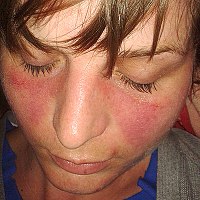
Photo from wikipedia
Localized cutaneous leishmaniasis (LCL) can ultimately progress to chronic ulcerated lesions with strong local inflammatory reactions. The functional role of certain inflammasomes in mediating inflammation caused by Leishmania braziliensis needs… Click to show full abstract
Localized cutaneous leishmaniasis (LCL) can ultimately progress to chronic ulcerated lesions with strong local inflammatory reactions. The functional role of certain inflammasomes in mediating inflammation caused by Leishmania braziliensis needs to be addressed. By combining PCR-array, quantitative real-time PCR and immunohistochemical analysis, we identified inflammasome genes, such as IL-1β, NLRP3, NLRP1, NLRC5, AIM2 and P2RX7, that were upregulated in LCL patients. Temporal gene expression studies showed that the early phase of LCL displayed increased NLRP3 and reduced AIM2 and NLRP1 expression, while the late stages showed increased AIM2 and NLRP1 and lower NLRP3 expression. Our findings also showed that AIM2, NLRP1, and P2RX7 promoted susceptibility to experimental L. braziliensis infection. These results highlight the importance of inflammasome machinery in human LCL and suggest that inflammasome machinery plays a role in the acute and chronic phases of the disease.
Journal Title: Cellular immunology
Year Published: 2019
Link to full text (if available)
Share on Social Media: Sign Up to like & get
recommendations!